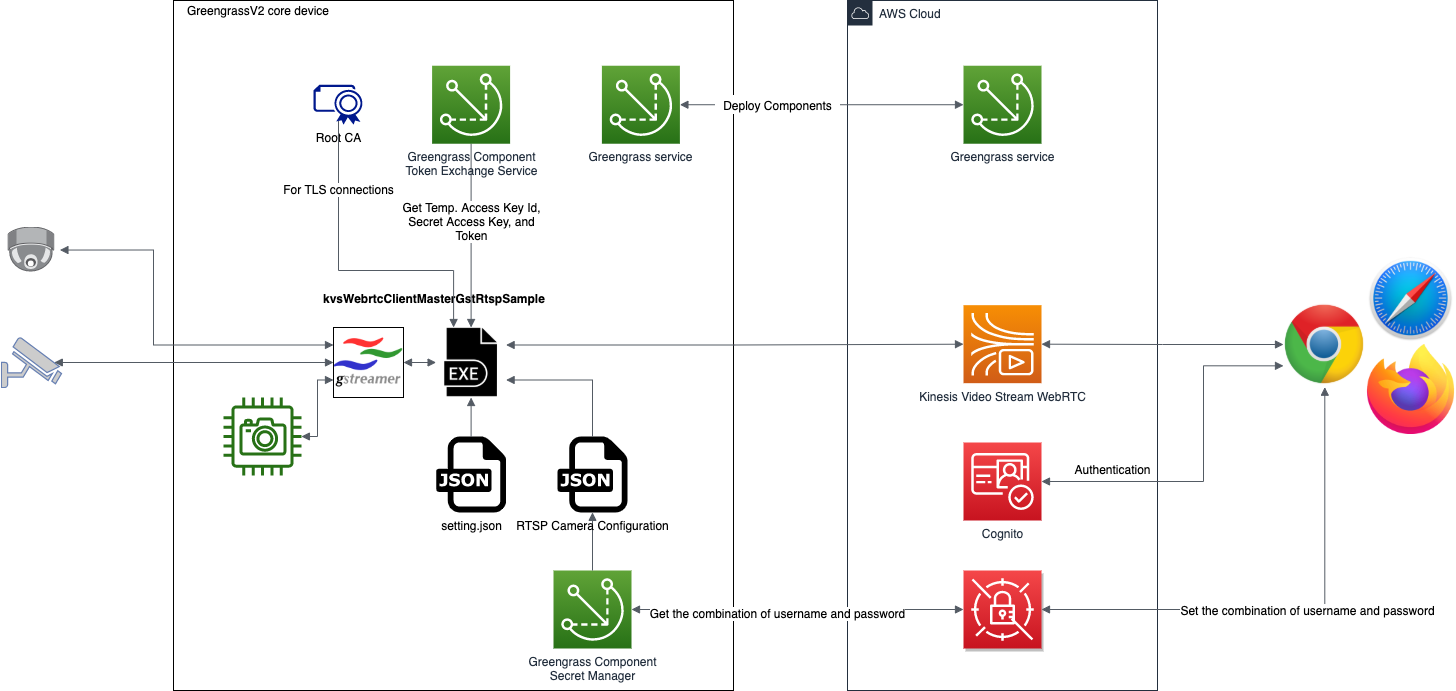This is an application that runs on AWS IoT Greengrass v2 gateway devices as a Greengrass Component. The app receives video streams from multiple IP cameras, allowing remote viewers to watch the streams using Amazon Kinesis Video Stream WebRTC.
- GreenGrassV2 Please setup your device if it does not have Greengrass v2. See Install the AWS IoT Greengrass Core software.
- GStreamer GStreamer should be installed on the device. GStreamer is a pipeline-based multimedia framework. This app uses its plugin, rtspsrc, to receive video streams from RTSP cameras. See Installing GStreamer.
- Python3 We use aws-iot-device-sdk-python-v2 on the GreengrassV2 devices, so you need to install Python3.
- AWS Command Line Interface (CLI) We provide bash shell scripts based on AWS CLI for installing and configuring the app. Please install AWS CLI on your desktop PC following Configuring the AWS CLI.
- jq Our shell scripts are based on jq. See Download jq
Please build the image by following these steps. The app links to GStreamer dynamically, therefore you MUST have the dynamically linked libraries of GStreamer on your devices. (See Prerequisite Setup.)
After cloning this project:
$git submodule update --init
$cd source/amazon-kinesis-video-streams-webrtc-sdk-c
$git apply --ignore-whitespace ../patches/0001-ecs-support.patch
$cd ..
$mkdir build && cd build && cmake ..
$make
$cp awsGreengrassLabsWebRTC your-artifact-path
To build unit tests, the submodule dependency of CMock is required. Use the following command to clone the submodule:
$git submodule update --checkout --init --recursive source/test/unit-test/CMock
- For running unit tests
- C90 compiler like gcc
- CMake 3.13.0 or later
- Ruby 2.0.0 or later is additionally required for the CMock test framework (that we use).
- For running the coverage target, gcov and lcov are additionally required.
- Run the steps of Build and go to the source folder under the root directory of this repository. (Make sure that the CMock submodule is cloned as described)
- Run the cmake command:
cmake -S test -B build - Run this command to build the library and unit tests:
make -C build all - The generated test executables will be present in
build/bin/testsfolder. - Run
cd build && ctestto execute all tests and view the test run summary.
We provide three shell scripts for generating all artifacts. To use these scripts, you need to provide the configuration of RTSP cameras and the name of your IoT Thing for the Greengrass device.
Step. 1: Generate resources in AWS cloud for consuming video streams through WebRTC. You must provide all arguments needed by the script. This script will create policies and AWS resources (such as S3 bucket and AWS Secrets Manager resources) in your AWS account. It also generates artifact files and a recipe for the Greengrass app.
$bash scripts/generate-iot-greengrass.sh $aws_profile $iot_thing_name $component_name $component_version $your_s3_bucket_for_artifacts $secret_name $the-configuration-of-your-cameras $os $architecture
The example for Raspberry Pi 4 Model B:
$bash scripts/generate-iot-greengrass.sh default MyGreengrassCore aws.greengrass.labs.webrtc 1.0.0 aws-greengrass-labs-webrtc-bucket aws-greengrass-labs-webrtc-secret rtsp-camera-configuration.json linux armv7l
The example for Greengrass devices running Ubuntu 18.04:
$bash scripts/generate-iot-greengrass.sh default MyGreengrassCore aws.greengrass.labs.webrtc 1.0.0 aws-greengrass-labs-webrtc-bucket aws-greengrass-labs-webrtc-secret rtsp-camera-configuration.json linux x64
Step. 2: Upload the app. This app is built as a Greengrass v2 “component”. Please remember putting your awsGreengrassLabsWebRTC into artificats folder.
$bash scripts/upload-component-version.sh $WorkPath $aws_profile $component_name $component_version $your_s3_bucket_for_artifacts
Example:
$bash scripts/upload-component-version.sh . default aws.greengrass.labs.webrtc 1.0.0 aws-greengrass-labs-webrtc-bucket
Step. 3: Deploy this app along with other depended Greengrass components (Token Exchange Service and Secret Manager.)
$bash scripts/deploy-component.sh $aws_profile $iot_thing_name $component_name $component_version $your_s3_bucket_for_artifacts $secret_name
Example:
$bash scripts/deploy-component.sh default MyGreengrassCore aws.greengrass.labs.webrtc 1.0.0 aws-greengrass-labs-webrtc-bucket aws-greengrass-labs-webrtc-secret
In Step 1 of Configure Greengrass above, you need to provide a configuration file in JSON format. (This is the “$the-configuration-of-your-cameras” argument for generate-iot-greengrass.sh.) In this JSON file, you provide the username, password and URL of each camera. The "ChannelName" is the name of the WebRTC channel you want to associate to the camera. A viewer will use that name to find that camera.
{
"RtspConfig": [
{
"ChannelName": "the signaling channel of webrtc corresponds to your rtsp camera",
"RtspUrl": "the uri your rtsp camera",
"username": "the username of your rtsp camera",
"password": "the password of your rtsp camera"
},
{
"ChannelName": "the signaling channel of webrtc corresponds to your rtsp camera",
"RtspUrl": "the uri your rtsp camera",
"username": "the username of your rtsp camera",
"password": "the password of your rtsp camera"
}
]
}
If you do not use scripts/deploy-component.sh, but use the Greengrass console to deploy this app, you MUST add the following “merge” blocks in your deployment configuration. (See Configuration merge update.)
For AWS secret manager.
"merge": {
"cloudSecrets":[{"arn": "$SecretTargetArn"}]}"
}
For this app (component).
"merge": {
"IpcTimeout" : "10",
"RecipesBucketName" : "$ComponentArtifactsBucket",
"SecretArn": "$SecretName",
"accessControl": {
"aws.greengrass.SecretManager": {
"$ComponentName:secrets:1": {
"policyDescription": "Allows access to a secret.",
"operations": [ "aws.greengrass#GetSecretValue"],
"resources": [ "*"]
}
}
}
}
- Python plugins. These two are automatically installed if you use the provided scripts.
- Gtreamer, used for rtsp client. You need to install GStreamer by yourself. The version of GStreamer we’ve tested is 1.14.4. The dynamic libraries of GStreamer this app links to are:
libgstreamer-1.0.so.0
libgstapp-1.0.so.0
libgstbase-1.0.so.0
- Greengrass components, When you deploy this component, you MUST deploy the following components.
If you want to install Greengrass v2 on a device manually, you can type the following command after scripts/generate-iot-greengrass.sh generates the config.yaml, certificate and other necessary resources.
$. scripts/install-ggv2-ssh.sh $user $ip_address
See CONTRIBUTING for more information.
This project is licensed under the Apache-2.0 License.
